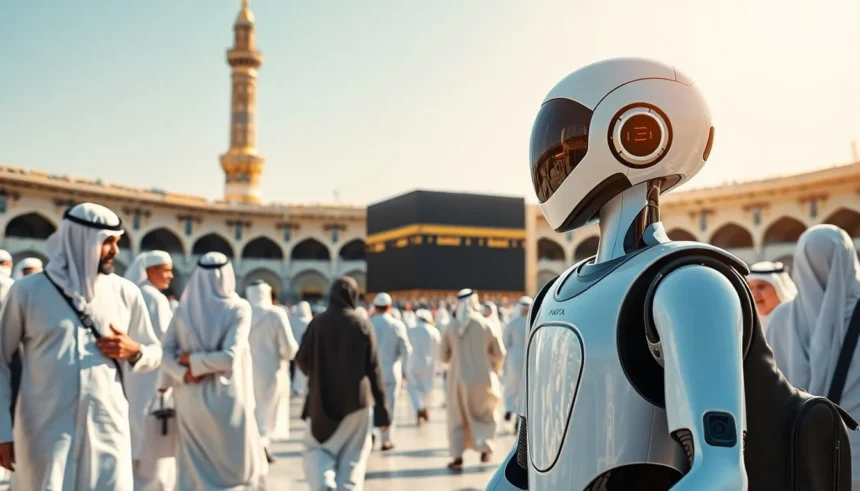Saudi Arabia Launches ‘Manara’: The AI-Powered Robot Revolutionizing Hajj and Umrah Pilgrim Assistance
Every year, millions of Muslims travel from all corners of the globe to perform Hajj and Umrah. These sacred journeys are some of the most important acts of worship in Islam. They bring together people from many different countries, languages, and cultures. Managing such huge crowds is a big challenge for organizers.
As the number of pilgrims grows, so do safety concerns and logistical hurdles. That’s why technology is playing a bigger role. Saudi Arabia has taken a bold step with a new tool called ‘Manara’, an AI-powered robot designed to help pilgrims. This marks a new chapter in how technology and faith come together to serve millions. It shows how innovation can make these sacred experiences safer and easier.
The Emergence of ‘Manara’: Saudi Arabia’s Technological Leap in Religious Services
Development and Introduction of ‘Manara’
Saudi Arabia’s government decided to modernize pilgrimage support systems. They aimed to use AI and robots to help guide, inform, and protect pilgrims. Development started a few years ago, led by tech experts and religious officials. The first ‘Manara’ robots appeared during the latest Hajj season, stationed at key points like the Masjid al-Haram and Mina.
The goal is clear: reduce chaos, prevent accidents, and give pilgrims a smoother journey. Making the pilgrimage safer and more comfortable is a top priority. By deploying ‘Manara’ in strategic locations, officials hope to offer better service and improve crowd control.
Technological Foundations of ‘Manara’
So, what makes ‘Manara’ special? It is loaded with smart features. It uses artificial intelligence to understand and respond in multiple languages. Whether you speak English, Arabic, Urdu, or other languages, ‘Manara’ can communicate clearly. It also guides visitors step-by-step through rituals, helping them find sacred sites without confusion.
Robots like ‘Manara’ are equipped with sensors, cameras, and machine learning. These tools help it adapt to the busy, ever-changing environment of the pilgrimage site. It tracks crowd density, finds the fastest routes, and alerts helpers if emergencies arise. This real-time data makes pilgrimage management smarter and safer.
The Rationale for AI in Pilgrimage Assistance
Handling large crowds has always been tough and sometimes risky. In recent years, pilgrims have increased, making the management process even more complex. Long waits, language barriers, and health emergencies can turn chaotic quickly.
Experts see AI as a solution. It can support crowd control, quicken responses, and offer personalized help. AI makes it easier to keep everyone safe during these spiritual gatherings. Saudi Arabia’s move reflects a desire to combine faith with innovation, ensuring safety while respecting tradition.

Key Features and Functionalities of ‘Manara’
Multilingual Support and Cultural Sensitivity
Pilgrims come from diverse backgrounds. ‘Manara’ speaks multiple languages fluently. It offers assistance in Arabic, English, Urdu, Indonesian, and more. Its programming respects religious customs and cultural sensitivities. When interacting, it avoids sensitive topics and shows respect in every exchange.
Navigation and Guidance
One of ‘Manara’s’ biggest strengths is guiding pilgrims. It points out the locations of key rituals, sacred mosques, and logistical points like gates or rest areas. If an area gets crowded, it suggests alternative routes to avoid delays. This helps pilgrims stay safe and reach their destinations faster.
Health Monitoring and Emergency Assistance
Beyond guidance, ‘Manara’ keeps an eye on health. It can monitor vital signs through connected sensors. If it detects signs of illness or stress, it alerts medical teams immediately. In case of accidents or health emergencies, it quickly communicates with emergency services, reducing response times.
Educational and Informational Support
Many pilgrims want to learn more about the history and significance of each site. ‘Manara’ offers educational info, giving quick facts about the Kaaba, Prophet Muhammad’s life, and other important topics. It can answer common questions and engage pilgrims with interactive discussions, enriching their spiritual experience.
Impact of ‘Manara’ on Pilgrimage Experience and Management
Enhancing Safety and Security
Since its deployment, ‘Manara’ has helped control crowds and reduce incidents. Reports suggest fewer stampedes and accidents at busy points. Its ability to monitor crowd flow in real time allows authorities to act fast and prevent dangers. Safer pilgrimages mean more peace of mind for everyone.
Improving Accessibility for All Pilgrims
Older adults, disabled visitors, and first-timers benefit greatly. ‘Manara’ can assist with directions, language, and even provide companionship. Testimonials show that pilgrims feel more confident and cared for thanks to this technology. It’s a major step toward making pilgrimage inclusive and welcoming.
Operational Efficiency and Cost Reduction
Using ‘Manara’ means less need for large staff teams for guidance and security. Pilgrimage sites operate more efficiently, with resources allocated better. Automated assistance reduces waiting times and helps manage the large crowds more effectively. Over time, this could lead to significant cost savings for organizers.
Future Developments and Expansion Plans
Saudi Arabia plans to improve ‘Manara’ with new features. Upcoming versions might include better emotional recognition, more languages, and expanded coverage of non-Hajj sites. Integrating ‘Manara’ with broader smart infrastructure could make the entire pilgrimage experience smoother and more futuristic.
Expert Perspectives and Reactions
Many officials praise ‘Manara’s’ innovations. Saudi officials call it a “milestone” in pilgrimage safety. Tech experts see it as a model for other countries managing large religious gatherings. Religious scholars highlight how AI can support faith practices without replacing human warmth.
Globally, the move inspires other nations to adopt AI in managing religious events. It shows how technology can respect tradition while ensuring safety and convenience.
Actionable Tips for Pilgrims and Stakeholders
- To get the most out of ‘Manara’, approach it with clear questions. Speak slowly and patiently.
- Service providers should train staff on how ‘Manara’ works. They can assist pilgrims in using it.
- Organizers should gather feedback from pilgrims after each visit. Use this info to improve ‘Manara’ continuously.
- Keep updating the system with new data, ensuring it learns and adapts to changing needs.
Conclusion
‘Manara’ marks a bold step in transforming how pilgrims access guidance and safety during Hajj and Umrah. It combines faith with smart technology, making the journey safer and more inclusive. As Saudi Arabia continues to lead in this area, the world watches closely. The future of religious tourism looks brighter, more connected, and safer thanks to innovations like ‘Manara’.

